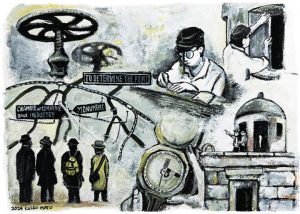Hiroshima and Film, Part 4: Takeshi Sato―Senior specialist for visual culture, Hiroshima City Cinematographic and Audio-Visual Library
Oct. 19, 2024
“Effects of the Atomic Bomb on Hiroshima and Nagasaki” (Produced in 1946)
Film record of the A-bombed cities confiscated by the United States
“Effects of the Atomic Bomb on Hiroshima and Nagasaki” is a rare full-length documentary in the history of Japanese cinema, filmed in the very early postwar period from September 1945 to January 1946 in Hiroshima and Nagasaki, where atomic bombs were dropped by the United States, by Japanese staff from a scientific investigative point of view.
The Japan Film Corporation, the single producer of newsreels and documentaries after the wartime integration, asked Dr. Yoshio Nishina, a leading expert in atomic physics, for help in documenting the devastation of the A-bombed cities. Soon, a “Special Committee for the Investigation of A-bomb Damages” was established in the Ministry of Education’s Scientific Research Council of Japan, and an academic survey team was formed. The camera crew was divided into five teams: a biology team, physics team, civil engineering and architectural team, medical team, and news and field reporting team, to accompany the survey team, and started full-scale filming in Hiroshima.
While filming on location in Nagasaki, they were ordered by the General Headquarters of the Supreme Commander of the Allied Powers (GHQ) to stop. The United States tried to seize the exposed film, but Japan Film explained much work was still needed to complete the film. As a result of negotiations, they were able to resume filming in a form commissioned by the United States Strategic Bombing Survey Team. Under the supervision of GHQ, the 35mm film “Effects of the Atomic Bomb on Hiroshima and Nagasaki” was completed in April 1946. Preview screenings of the documentary, which was narrated by Japanese in English, were held only for the Japanese and American personnel involved.
The film, along with other related materials, was confiscated by the United States and had long been called an illusory film. In 1967, a 16mm copy from the original was returned to Japan. It was released to the general public by cutting out certain parts, such as the facial expressions of the people shown, to protect their human rights. Later, the release of the uncut version was realized through a campaign called the “10 Feet Film Project.”
The unedited footage from the documentary was used in Fumio Kamei’s film “Ikiteite Yokatta” (in English, ‘Still it’s Good to Live’; released in 1956) and Alain Resnais’ “Hiroshima Mon Amour” (released in 1959). GHQ tried to take all film-related material, including unprocessed negatives and even their fragments, in addition to the full-length film. However, the film production staff made two order slips to the processing laboratory and made an extra silent rush print, which was secretly kept in Japan.
Since its opening in 1982, the Hiroshima City Cinematographic and Audio-Visual Library has collected masterpieces of Japanese film, works by filmmakers with links to Hiroshima, and narrative films about the atomic bombings, and since the 2000s has expanded its collection to include documentaries. In 2009, a joint project with the National Film Archive of Japan and Nichiei Eizo, successor to the Japan Film Corporation, enabled the Library to acquire the 35mm copy of “Effects of the Atomic Bomb on Hiroshima and Nagasaki” held by the U.S. National Archives and Records Administration.
We want to continue to fulfill our mission as the archive of Hiroshima, which sends out the message of peace, by collecting, preserving, and making available to the public works related to the atomic bombings.
Takeshi Sato
Born in Hokkaido in 1959. He began working for the Hiroshima City Cinematographic and Audio-Visual Library in 1990. He makes efforts to collect and show films, and has organized many projects about people in the film world with links to Hiroshima, including Kaneto Shindo and Kyoko Heya. He was part of the project that discovered the Japanese film “Chuji Tabi Nikki” (in English, ‘A Diary of Chuji’s Journey”) in 1992.
Hato
Born in Otake City in 1981. Her real name is Keiko Hata. She creates a wide range of formative arts, including painting, graphic design, stop-motion animation, and theatrical art.
Information on the film
Japan / 164 min. (Hiroshima version: 81 min.; Nagasaki version: 83 min.) / Japan Film Corporation
[Producer] Ryuichi Kano
[Film directors]
Biology team part: Dairokuro Okuyama
Physics team part: Shuji Aihara
Civil engineering and architectural team part: Sueo Ito
Medical team part: Shotaro Yoshida (assistant director)
News and field reporting team part: Chozo Obata
[Still photographs] Shunkichi Kikuchi and Shigeo Hayashi
(Originally published on October 19, 2024)








